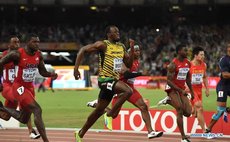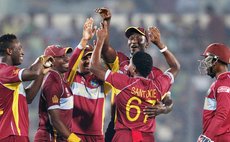The bricks and mortar of a good cricket team - part 5
The art of the spinner
Just as a quality team may seek the advantage of having three top pace bowlers in its lineup; there can be equal success from fielding three good spinners. The usual recipe could be two off spinners and one orthodox left arm spinner. One of the off spinners would be faster through the air in the general sense while his counterpart would be more given to dealing in deceptive flight. By and large; the introduction of spin comes along when the ball would be about twenty to twenty – five overs old or, let's say after the innings would be an hour and a half in progress.
The big question centres on what sort of a job the captain needs his spinners to do for him. If it means merely introducing some variety into the attack or giving his pacers a rest, the spinners are required to do this job with supreme confidence --- by no means to ease up the pressure on the batsmen. If anything, such a situation could be tailor made for a few wickets to be prized out briskly against unsuspecting batsmen.
This is where the countless hours spent in very well applied practices pays excellent dividends. Inevitably, the senior spinner will be allowed choice of ends. For instance, an off-spinner like the late Kelleb Laurent would desire the southern end at Botanic Gardens if the batting surface slopes (ever so gently) towards the eastern side. This aids his off breaks and adds to the potency of his faster and straighter delivery. That's where many of his LBW victims originated, not to mention his countless casualties ending up caught at short leg, duped by an absence of his otherwise prodigious spin.
Laurent was right armed, lanky in physique, had long arms and long fingers. His counterpart at the opposite end would be shorter in build and probably a leftarmer or a right arm leg spinner, like J.C. Josephs. Such men relied on good close-in fielders and on an excellent wicketkeeper. Standard fare was a slip, gully, backward point, cover, extra cover, short leg, short midwicket and maybe a fielder or two in the deep.
Given an opposition score of around 60 for 4 wickets, the job being asked of the spinners would be to restrict the middle order to not much more than an addition of 40 runs and in the interim the capture of another three wickets before the pace bowlers are reintroduced. All this presumes the opposing team to be only of moderate capability. To be effective the spinners will need to be tight while employing variations in spin and flight --- without being guilty of poverty in control. The captain does not want any promising buildup to be diffused by lapses into poor bowling, like very short pitched deliveries easily carted to the boundary.
Very much of this desired control derives from assiduous work done in the nets. This also is the place where the left arm spinner cultivates the art of delivering with great skill the dangerous arm ball ---- the one that comes in with the arm rather than turning away from the right handed batsman.
Work of this kind in the nets demands in large measure a strong collaboration between bowler, keeper, captain and the close- in fielders. Rather than the keeper falling victim to surprise when the bowler attempts his googly or even his quicker one it may be of assistance if the signal to bowl such delivery is initiated by the keeper. Of course, such signal has to be unobtrusive if the element of deception is to be a potent factor !
Mastery by the bowler of the properly flighted delivery can only be attained in the nets. Proof of quality in this respect is reflected in the batsmen not being inclined to use their feet enterprisingly. It is difficult to describe good flight, except perhaps to say the ball looks as if it might be over pitched, only for it to come down steeply ---- as if it is jerked down by a string tied to it. Of course, the bowler is the one holding the imaginary string and the desired effect is sometimes assisted while bowling into a slight breeze. Needless to say, a particular bowler may succeed admirably with his flighted deliveries on certain rays or against certain batsmen.
Not often dealt with is the art of wrist spin. As the term implies, the ball is spun more by wrist action than finger action. Those who bowl this well enjoy domination of most batsmen, even the best. At the instant of delivery the right arm wrist spinner holds the seam of the ball pointing towards slip to produce the legbreak to the right handed batsman. At that moment the bowler gives impression of pulling down on the front part of a wheel positioned vertically. To mix in the googly, the bowler dips his hand smartly to allow the ball to be released from the back of his hand. The real danger to the unseasoned wrist spinner is two-fold. He has to avoid inaccuracy with the googly and against really good batsmen he must avoid telegraphing the googly by dipping his left shoulder prior to the actual delivery ! My suggestion, as a very last resort, is to learn to dip the left shoulder while also bowling both the leg break and the straight ball ! This should keep the batsman worried. That's if he isn't dismissed early.
Most spinners enjoy bowling on a turning pitch. Yet, at times excessive spin can be a hindrance. The ball turns too much, batsmen hold their ground and miss by a mile ! That's where the good spinner has to develop a delivery that turns less and also a straight ball. Thus has the effect of keeping batsmen honest. Similarly, the bowler with a very well disguised googly may do well to bowl one or two googlies right at the start of his spell in order to have the batsmen looking for it --- while his subsequent deliveries are comprised of standard legbreaks. All this puts the batsman off balance.
We end this series with a hint on how the spinner could best deal with the hard hitting slogger and how the captain could make his job of captaincy more effective! The spinner may gain advantage of directing the ball directly at the stumps, with very little spin and aimed right up to the block hole. The captain can make his job easier by scouting the opposing teams in their earlier matches while making careful note of all the challenges expected to be faced and working out an intelligent team plan: Good Luck !




